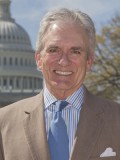 By Executive Director J. Brent Walker
By Executive Director J. Brent Walker
The year before I came to the Baptist Joint Committee, Allen Hertzke — a political science professor at the University of Oklahoma — published a groundbreaking and now-classic book, audaciously titled Representing God in Washington: the Role of Religious Lobbies in the American Polity.
In addition to exploring generally the role of religion and religious bodies in the formulation of policy at the national level, the 1988 book illuminated the tensions between religious compunction and political imperatives, between conviction and compromise. Hertzke concluded that the work of so-called religious lobbies on Capitol Hill generally “mirror the theological, organizational, ethnic, and regional diversity of American religion.” And, contrary to what some had alleged, these groups did not seem to exhibit the elitism that often characterized their secular counterparts.
I have always appreciated Hertzke’s inclusion of the Baptist Joint Committee in his analysis. He focused at length on the BJC’s leadership — through James Dunn and then-General Counsel John Baker — in the effort to pass the landmark Equal Access Act of 1984. Hertzke tersely observed that the BJC “played a pivotal role in [its] passage” and chaired the committee that drafted the helpful guidelines for the law’s implementation that allows religious clubs to meet before and after school on public school campuses.
Hertzke concluded that the effort to pass the Equal Access Act — and its ultimate adoption — “provides a picture of the nature of modern lobbying and is a classic example of the consensus-seeking congressional process, which aims to accommodate simultaneously many conflicting values and interests.”
Much has changed over the past 25 years — not only in Congress, but among religious lobbies. Although the goodwill spawned by the work on the Equal Access Act and consummated by stronger bands binding diverse groups together in the even broader coalition that urged passage of the Religious Freedom Restoration Act of 1993, much of that spirit of cooperation has dissipated. The tension between liberty and equality, between religious accommodation and anti-discrimination laws — most notably dealing with LGBT rights and same-sex marriage — has diminished the traditional consensus.
This has been exacerbated by the emergence of not only many more religious groups (especially on the religious and political right) but a burgeoning of groups on the secular left (including those providing an atheistic critique of religion in the public square). The disagreements that we have always had about the proper interpretation of the First Amendment’s Establishment Clause are now pulling us apart on free exercise issues as well.
Into this milieu, Professor Hertzke has edited a new book titled Religious Freedom in America: Constitutional Roots and Contemporary Challenges. I doubt that it was meant to “bookend” the past quarter century with Representing God. But, it is a welcomed contribution to helping us negotiate the dizzying diversity of our contemporary religious liberty challenges and how they fit within our constitutional traditions.
Hertzke offers a “Madisonian framework” for applying constitutional principles on religion. This context is entirely appropriate, not only because James Madison is the father of our Constitution, but also because he — perhaps even more than the likes of John Locke, Thomas Jefferson and Roger Williams — understood both the preeminence of the rights of conscience and the value of Enlightenment thought. He also exhibited a more mature synthesis of both the principles of “no establishment” and “free exercise” as embodied in those two religion clauses in the First Amendment.
The book unfolds with a cornucopia of essays unpacking the evolution of Madisonian thinking. The most notable are penned by longtime BJC friends Steve Green (law professor at Willamette University) and Charles Haynes (director of the Religious Freedom Center of the Newseum Institute) dealing with the school prayer debate and religious liberty in the public schools, respectively.
The book later explores four practical challenges dealing with current hot-button topics such as issues surrounding contraception, abortions and the rapid cultural acceptance of same-sex marriage. Finally, the book concludes with a pair of essays by Rajdeep Singh (director of law and policy at the Sikh Coalition) and Asma Uddin (counsel at the Becket Fund) talking about the unique religious liberty challenges confronting the Sikh and Muslim communities, respectively.
This new effort by Professor Hertzke and the other contributors provides a helpful tool for assisting those of us who do not presume to “represent God” but who do attempt to articulate our God-inspired understanding of the proper relationship between church and state and the importance of a civil conversation in our religiously plural and politically contentious society.
Oh, by the way, I recommend both books to your reading, too.
From the March 2015 Report from the Capital. Click here to read the next article.





